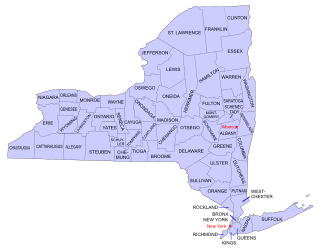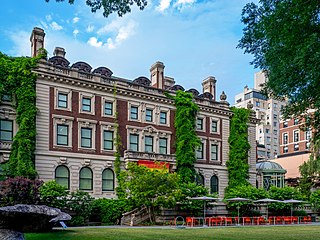
Fifth Avenue is a major and prominent thoroughfare in the borough of Manhattan in New York City, New York, United States. It stretches north from Washington Square Park in Greenwich Village to West 143rd Street in Harlem. It is one of the most expensive shopping streets in the world.

Buildings, sites, districts, and objects in New York listed on the National Register of Historic Places:

The Church of St. Vincent Ferrer is a Roman Catholic parish in the Upper East Side of Manhattan, New York City. It was built in 1918 by the Dominicans; the attached priory serves as the headquarters of the Eastern United States Province of the order. Its architecture has some unusual features: above the front entrance is one of the few statues of the Crucifixion on the exterior of an American Catholic church; and inside, the Stations of the Cross depict Christ with oil paintings instead of statuary or carvings. It has two Schantz pipe organs. The church building, at the corner of Lexington Avenue and East 66th Street in the Lenox Hill section of the Upper East Side, has been called "one of New York's greatest architectural adornments."

The Andrew Carnegie Mansion is a historic house located at 2 East 91st Street at Fifth Avenue in the Upper East Side of Manhattan, New York City, New York. Andrew Carnegie moved into his newly completed mansion in late 1902 and lived there until his death in 1919; his wife, Louise, continued to live there until her death in 1946. The building is now the Cooper-Hewitt, Smithsonian Design Museum, part of the Smithsonian Institution. The surrounding area, part of the larger Upper East Side neighborhood, has come to be called Carnegie Hill. The mansion was named a National Historic Landmark in 1966.
These are lists of New York City landmarks designated by the New York City Landmarks Preservation Commission:

The 369th Regiment Armory is a historic National Guard Armory building located at 2366 Fifth Avenue, between West 142nd and 143rd Streets, in Harlem, Manhattan, New York City. It was built for the 369th Regiment, also known as the "Harlem Hellfighters", founded in 1913 as the first National Guard unit in New York State composed solely of African-Americans. It later became home to the 369th Sustainment Brigade.

The houses at 208–218 East 78th Street in Manhattan, New York, United States, are a group of six attached brick rowhouses built during the early 1860s, on the south side of the street between Second and Third Avenues. They are the remnant of 15 built along that street as affordable housing when the Upper East Side was just beginning to be developed.

The Church of the Incarnation is a historic Episcopal church at 205–209 Madison Avenue at the northeast corner of 35th Street in the Murray Hill neighborhood of Manhattan, New York City. The church was founded in 1850 as a chapel of Grace Church located at 28th Street and Madison. In 1852, it became an independent parish, and in 1864–1865 the parish built its own sanctuary at its current location.

The Lewis Gouverneur and Nathalie Bailey Morris House is a historic building at 100 East 85th Street on the Upper East Side of Manhattan in New York City. The five-story dark red brick house was built in 1913-14 as a private residence for Lewis Gouverneur Morris, a financier and descendant of Gouverneur Morris, a signer of the Articles of Confederation and United States Constitution, and Alletta Nathalie Lorillard Bailey. In 1917, Morris & Pope is bankrupt but the family retains ownership of this house as well as their house in Newport, RI because his wife owned the property as collateral for a loan to him for his brokerage business. Alletta Nathalie Bailey Morris was a leading women's tennis player in the 1910s, winning the national indoor tennis championship in 1920.

The W New York Union Square is a 270-room, 21-story boutique hotel operated by W Hotels at the northeast corner of Park Avenue South and 17th Street, across from Union Square in Manhattan, New York. Originally known as the Germania Life Insurance Company Building, it was designed by Albert D'Oench and Joseph W. Yost and built in 1911 in the Beaux-Arts style.

The Park Avenue Houses in New York City were built in 1909. They were added to the National Register of Historic Places in 1980.

The Lucy Drexel Dahlgren House is a historic home located at 15 East 96th Street between Fifth and Madison Avenues in Manhattan, New York City. It is on the border between the Carnegie Hill, Upper East Side, and East Harlem neighborhoods on the Upper East Side, within the Upper East Side Historic District. A private house used at one time as a convent, it was built in 1915–16 for Lucy Wharton Drexel Dahlgren. It is a New York City Landmark and is on the National Register of Historic Places.

The 14th Regiment Armory, also known as the Eighth Avenue Armory and the Park Slope Armory, is a historic National Guard armory building located on Eighth Avenue between 14th and 15th Streets in the South Slope neighborhood of Brooklyn, New York City, United States. The building is a brick and stone castle-like structure, and designed to be reminiscent of medieval military structures in Europe. It was built in 1891–95 and was designed in the Late Victorian style by William A. Mundell.

The Met Fifth Avenue is the primary museum building for the Metropolitan Museum of Art in New York City. The building is located at 1000 Fifth Avenue, along the Museum Mile on the eastern edge of Central Park in Manhattan's Upper East Side.

488 Madison Avenue, also known as the Look Building, is a 25-story office building in the Midtown Manhattan neighborhood of New York City. It is along Madison Avenue's western sidewalk between 51st and 52nd Streets, near St. Patrick's Cathedral. 488 Madison Avenue was designed by Emery Roth & Sons in the International Style, and it was constructed and developed by Uris Brothers. The building was originally named for its primary tenant, the American magazine Look.

The Turtle Bay Gardens Historic District is a collection of twenty rowhouses in the Turtle Bay neighborhood of Manhattan in New York City. They consist of eleven houses on the south side of 49th Street and nine on the north side of 48th Street, between Second and Third Avenues. The rowhouses, dating from the 1860s, were renovated between 1918 and 1920 by Charlotte Hunnewell Sorchan to plans by Clarence Dean.
The following is an alphabetical list of articles related to New York City. New York City is a city in the United States state of New York.




















